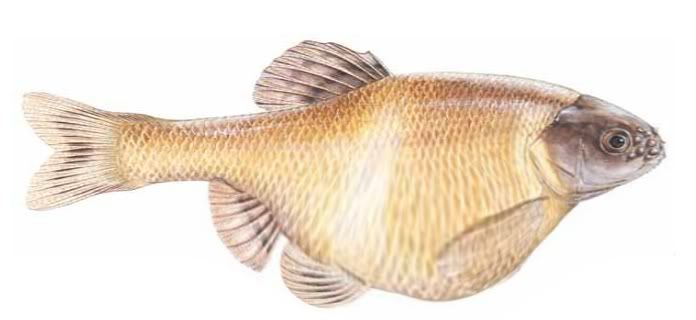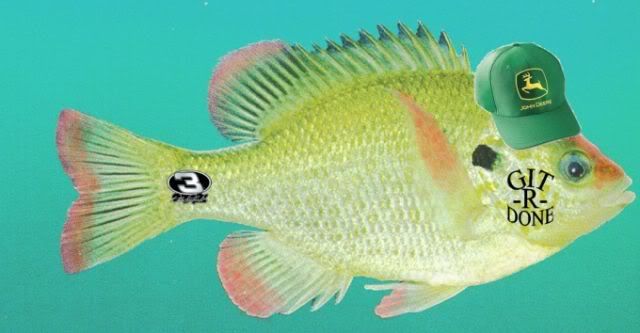New Species of Fish for PondsI am happy to present previously unavailable data on four little-known species of fish inhabiting North American ponds. They include two forage species, a top-line predator, and a new variety of bream.
FatA** Minnow (Gluteus maximus)The FatA** Minnow (FAM) is a large, slow moving species that has the potential to be one of the best forage species for trophy bass management, providing oversized meals for oversized predators. They can be a difficult species to maintain in ponds with any predator large enough to eat them, however, since they seldom move enough to avoid predation.

Figure 1: The FatA** Minnow
RANGE: Found throughout the United States and Canada.
APPEARANCE: G. maximus grows to be among the largest of the North American minnow family, no doubt due to it's sedentary lifestyle and constant eating habits. Older FAMs tend to add mass only in the abdomen and in close proximity to the anal fins.
SPAWNING: Little is known of the FAM's spawning habits. We have been unable to find any researchers willing to observe G. maximus in spawning situations. Even for money.
DIET: Experience has shown that G. maximus will eat whatever is easily within reach, including many food items considered unhealthy for steady consumption by other fish.
STRUCTURE PREFERENCES: G. maximus seems to be inherently drawn to structures allowing it to feed without movement. This suggests that FAM-oriented structure should be placed close to the surface to allow sufficient sunlight for algal growth and subsequent small invertebrate infestation. The most successful items for artificial FAM structure have been found to be discarded chairs and sofas placed in close proximity to old television sets.
Closedmouth Bass (Micropterus hartleyus)Increasing numbers of this newly identified species of black bass have been reported. Usually considered undesirable, the Closedmouth Bass (CMB) is best known for refusing all artificial lures as well as most live baits.

Figure 2: The Closedmouth Bass
RANGE: Generally believed to have originated in Florida, the CMB is perhaps best known in east Texas near the Louisiana state line. They can, however, be found in unlucky bass lovers' ponds anywhere.
APPEARANCE: Typical black bass shape and appearance. Most CMBs are reported as having exceptional size and relative weight. It seems the only fish consistently bigger than "the one that got away" is "the one you can never hook in the first place."
SPAWNING: May not spawn in beds as other black bass do, as CMBs have never been caught off of spawning beds (or anywhere else).
DIET: Unknown. Most pondmeisters with CMB report they will not bite on anything.
STRUCTURE PREFERENCES: CMB prefer the same structure as the other black bass species inhabiting the same water. They seem to specialize in forcing other bass away from artificial structure placed to concentrate large predators for fishing purposes.
Golden Shriner (Notemigonis illuminatus)The Golden Shriner (GSR) is found in many American ponds and lakes, at least during warm weather months. While it would seem probable that GSR are present in these waters year-round, they have chiefly been observed on or near Summer holidays such as the 4th of July and Labor Day. Some authorities believe that GSR leave colder climates and migrate to Florida in the Winter.

Figure 3: The Golden Shriner
RANGE: Located throughout the entire country, GSR tend to be concentrated in and around urban areas.
APPEARANCE: Neat and dapper, the typical GSR appears aged but well preserved. The red bump that is invariably present on the head is a normal part of GSR physiology, not a parasite or tumor as is sometimes thought.
SPAWNING: Despite years of research and study, GSR have never been observed exhibiting spawning behavior. The exact nature of GSR reproduction remains a mystery, compounded by the fact that only elderly male GSRs have ever been collected from the wild. Some researchers believe that GSR do not spawn at all, but rather recruit their members from other species of fish once they reach a certain social and economic status.
DIET: The preferred GSR diet consists of highballs, dry martinis, prunes, and circus food. Although it gives them gas.
STRUCTURE PREFERENCES: Antique fire trucks and 1/10 scale model aircraft.
Redneck Sunfish (Lepomis bubba)The Redneck Sunfish (RNS), better known in some areas as the Whitetrash Perch, is a moderately large member of the Lepomis genus. Adult sizes vary greatly.

Figure 4: The Redneck Sunfish (Summer form)
RANGE: The RNS is believed to have been found originally over most of the Midwest and Southeastern portions of the country, primarily concentrated in the backwaters of the Appalachian mountains and their foothills. The species has spread so widely as to be ubiquitous in the lower 48 states, making it hard to determine the exact original range. The RNS has also been widely introduced abroad. Although they are not appreciated overseas, Rednecks are well known in every country commonly visited by American citizens.
APPEARANCE: RNS are usually fairly pale, with darker, reddened patches being found on the face and fins in warm, sunny weather. The belly of this fish is, well, fish-belly white. Despite their pale appearance, Rednecks are considered quite colorful by most who encounter them. RNS are somehow frequently confused with mullets, despite the fact that the latter are predominantly salt water fish.
SPAWNING: RNS spawn most successfully in evening hours during weather with high air temperatures. The male prepares for spawning by rising to the surface and inflating with hot air to present a better appearance, at least to himself. One unusual requirement for Redneck spawning is that the water must contain an ethyl alcohol concentration of between 0.01 and 0.02%. Researchers believe that as the alcohol level rises, the male Redneck finds females more attractive and desirable than he would otherwise consider them. When the alcohol enhanced attractiveness of the female equals the male's inflated self image, spawning occurs. Experiments have shown that if the alcohol level is too high, the male RNS loses interest in females (and everything else) and enters a stupor-like state, usually lasting until the next morning. Spawning preparation will resume the following evening if suitable environmental conditions persist.
It is commonly believed that RNS breed at a younger age and inbreed more often than other members of the Lepomis genus. Careful studies by unbiased observers, however, have shown that Rednecks do not breed any sooner in life than other sunfish, nor are they more likely to spawn with close family members. Honest.
DIET: RNS consume a typical sunfish diet, consisting primarily of insects and other assorted invertebrates. There is a great deal of discussion as to whether or not Rednecks will eat snails as readily as Redear Sunfish do. This seems doubtful, as all RNS examined to date show pharyngeal teeth which are either missing or in poor condition.
STRUCTURE PREFERENCES: Among the artificial structure types commonly used as fish attractors in ponds, RNS prefer tires, the bigger the better. Oversized truck and tractor tires will consistently draw an inordinate number of Rednecks. Commercial aquaculturists producing RNS fingerlings for sale and grow out have found that the best spawning structures for Rednecks are old house trailers with abandoned cars placed in front of them on cement blocks.
- - - - - - - - - - - - - - - - - - - - - - - - - - - - -
While I have never personally observed CMB or FAM in any of the waters around here, I have no doubt of their existence. I suspect that I will have a good population of Golden Shriners when it warms up next year and they return from Florida. And I would like to state that I am very proud to have Rednecks swimming in my pond.
Merry Christmas, everyone!
-Theo